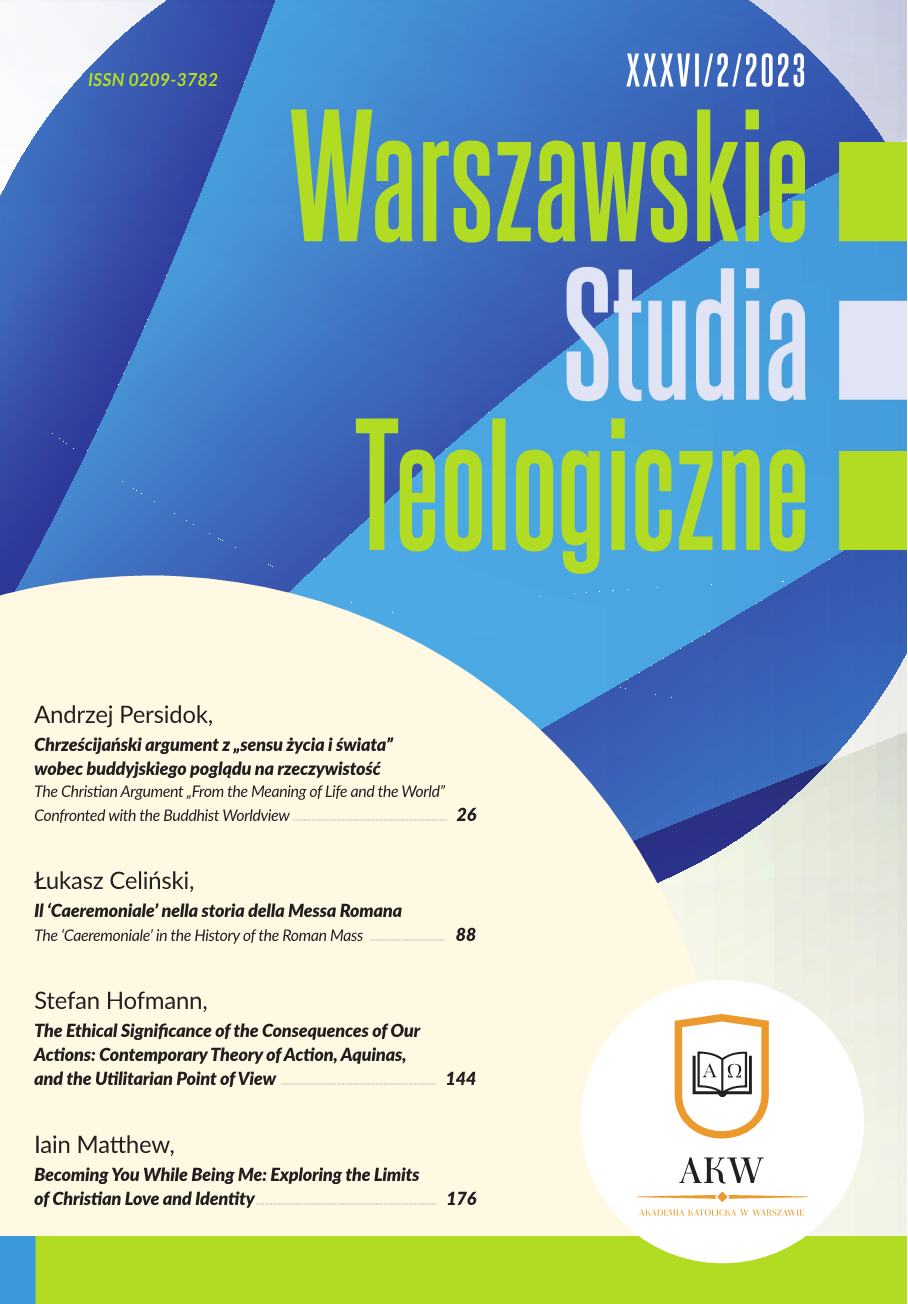Dying with Christ. Liturgical Celebration as a Companion for the Passage through Death to Life
Michel Steinmetz
michel.steinmetz@unifr.chUniversität Freiburg, Schweiz (Switzerland)
https://orcid.org/0000-0002-6633-5271
Abstract
Dying. This is one of the most decisive moments, if not the most decisive, in human existence. The same is true of the Christian life, where the challenge is precisely to die in Christ. However, the way in which contemporary reality views death and its accompaniment is overturning the habits established until the last few decades. This raises the question of whether there is a specifically Christian way of dying in order to die in Christ. Based on the liturgical institutions of funerals as they have developed over the centuries, the study then examines the liturgical books, in their French and German versions, to understand how each, with its specific features, attempts to respond to current paradigms and implement a Christian vision of the passage that is death. A reminder of the Eucharistic purpose of Christian life and its community roots could help to renew pastoral care at this time, both for the person who is about to die and for those close to him or her.
Keywords:
death, liturgical books, accompaniment, eucharist, communityReferences
Association Épiscopale Liturgique pour les pays Francophones (1977). Sacrements pour les malades, Pastorale et célébrations. Paris: Chalet-Tardy.
Google Scholar
Association Épiscopale Liturgique pour les pays Francophones. (2003). Missel des Défunts. Paris: Desclée-Mame. (Original veröffentlicht im Jahr 1973).
Google Scholar
Association Épiscopale Liturgique pour les pays Francophones. (2008). Dans l’espérance chrétienne, célébration pour les défunts. Paris: Desclée-Mame.
Google Scholar
Die Feier der Krankensakramente. Die Krankensalbung und die Ordnung der Krankenpastoral in den katholischen Bistümern des deutschen Sprachgebietes, zweite Auflage. (1994). Hg. im Auftrag der Bischofskonferenzen Deutschlands, Österreichs und der Schweiz sowie der (Erz-)Bischöfe von Bozen-Brixen, Lüttich, Luxemburg und Straßburg, Solothurn – Düsseldorf – Freiburg u.a. Verlag Herder.
Google Scholar
Die kirchliche Begräbnisfeier in den Bistümern des deutschen Sprachgebiets. (2009). Zweite authentische Ausgabe auf der Grundlage der Editio Typica 1969. Basel–Freiburg–Wien u.a. Pustet Friedrich KG.
Google Scholar
Die kirchliche Begräbnisfeier, Manuale. (2012). Hg. im Auftrag der Deutschen Bischofskonferenz, der österreichischen Bischofskonferenz und der Schweizer Bischofskonferenz sowie des Bischofs von Boxen-Brixen und des Bischofs von Lüttich. Trier: VzF Deutsches Liturgisches Institut.
Google Scholar
Congregation pour la doctrine de la foi (2016, 15. August). Instruction Ad resurgendum cum Christo sur la sépulture des défunts et la conservation des cendres en cas d’incinération. Rome. Abgerufen im Mai 2024 von https://www.vatican.va/roman_curia/congregations/cfaith/documents/rc_con_cfaith_doc_20160815_ad-resurgendum-cum-christo_fr.html.
Google Scholar
Andrieu, M. (1956). Les « Ordines romani » du Haut Moyen Age. Tome IV. Les Textes (suite) (Ordines XXXV-XLIX). Louvain.
Google Scholar
Février, P.-A. (1996). La mort chrétienne. In La Méditerranée de Paul-Albert Février (S. 289–360). Rome: École Française de Rome.
Google Scholar
Klöckener, M. (2011). Das eine Rituale und die vielen Feiern. Die Begräbnisliturgie in der Diskussion. In Heiliger Dienst 65. Jahrgang – 2011 (S. 42–67). Salzburg: Österreichisches Liturgisches Institut.
Google Scholar
La Documentation catholique. (1964), 61.
Google Scholar
Mariolle, B. (2022). Les sacrements à l’approche de la mort. Le viatique au passage de la mort dans la tradition de l’Église. Paris : Cerf.
Google Scholar
Martimort, A.-G. (1948). L’ordo commendationis animae. La Maison Dieu, 15.
Google Scholar
Ordo unctionis infirmorum eorumque pastoralis curae. (1972). Rome: Libreria Editrice Vaticana.
Google Scholar
Rebillard, É. (1991). La naissance du viatique: se préparer à mourir en Italie et en Gaule au Ve siècle. Médiévales, 20, 99–108.
DOI: https://doi.org/10.3406/medi.1991.1209
Google Scholar
Sacré congrégation suprême du Saint-Office. (1963, 5. Juli). Instruction Piam et constantem. Acta Apostolicae Sedis, 56 (1964), 822–823.
Google Scholar
Sicard, D. (1978). La liturgie de la mort dans l’Eglise latine des origines à la réforme carolingienne. Munster: Aschendorff.
Google Scholar
Sicard, D. (1980). La mort du chrétien en sa communauté. La Maison-Dieu, 144, 59–64.
Google Scholar
Simpson, Ch. (2024, 13. März). La crémation en France: évolutions et perspectives. Abgerufen von https://www.resonance-funeraire.com/magazine/dossiers/44-dossiers/6905-la-cremation-en-france-evolutions-et-perspectives.html.
Google Scholar
Statista Research Department (2024, 2. Oktober). Anteil von Sarg- und Urnenbestattungen in Deutschland in den Jahren 2012 bis 2023. Abgerufen im Mai 2024 von https://de.statista.com/statistik/daten/studie/1281529/umfrage/sarg-und-urnenbestattungen-in-deutschland/.
Google Scholar
Authors
Michel Steinmetzmichel.steinmetz@unifr.ch
Universität Freiburg, Schweiz Switzerland
https://orcid.org/0000-0002-6633-5271
Michel Steinmetz ist ordentlicher Professor für Liturgiewissenschaft an der Theologischen Fakultät der Universität Freiburg in der Schweiz. Er ist Doktor der Religionsanthropologie und Religionsgeschichte an der Sorbonne, Doktor der Theologie am Institut Catholique de Paris und Priester der Diözese Straßburg, wo er in der Seelsorge tätig war. Er ist Mitglied des Forschungsteams UR4377 an der Universität Straßburg und außerdem Mitglied des Forschungsteams „Rites et Spiritualité“ (Pôle „Textes et Herméneutiques“ der Forschungseinheit „Religion, Culture et Société“ EA 7403), des Redaktionskomitees der Zeitschrift La Maison-Dieu und der AKL (Arbeitsgemeinschaft katholischer Liturgiewissenschaftlerinnen und Liturgiewissenschaftler im deutschen Sprachgebiet).
Statistics
Abstract views: 172PDF downloads: 58
License
Copyright (c) 2024 Michel Steinmetz

This work is licensed under a Creative Commons Attribution-NoDerivatives 4.0 International License.

